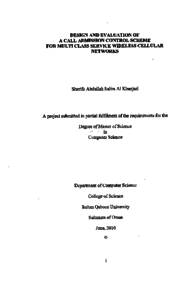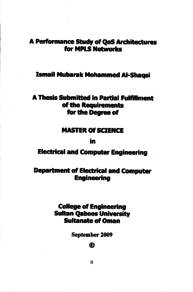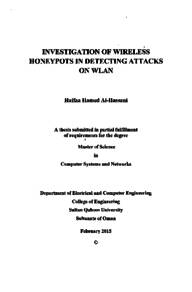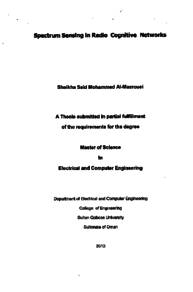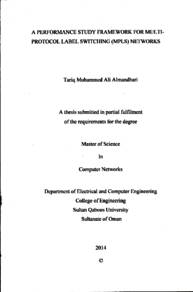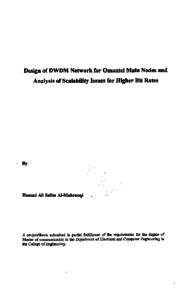Document
Design and evaluation of a call admission control scheme for multi class service wireless cellular networks.
Publisher
Sultan Qaboos University
Gregorian
2010
Language
English
Subject
English abstract
The recent fast advances in wireless mobile communication technologies have led to a wider range of requirements. Currently, third generation (3G) wireless cellular networks aim to provide multimedia services in addition to voice and data. However, the challenges facing 3G and next generation cellular networks are in maintaining the quality of service (QoS) requirements for each class of the multi service traffic in face of the limited radio resources and the mobility of users. In addition, the growing demand of mobile users for integration with the global communication infrastructure would necessitate their demand for having reliable services similar to wired communication and data networks. Accordingly, many issues should be addressed in 3G and next generation cellular networks to achieve the requirements for seamless roaming and internetworking.
The aim of this project is to develop an adaptive scheme for Call Admission Control (CAC) for multi-class service wireless cellular networks. The proposed CAC scheme is based on complete sharing of the available bandwidth among all traffic classes. This work proposes a CAC adaptive scheme that can be achieved through call bandwidth borrowing and call preemption techniques according to the priorities of the traffic classes. However, maintaining the QoS in each class to avoid performance deterioration is essential. Therefore, this research introduces mechanisms for call bandwidth degradation, and mechanisms for call bandwidth upgrading based on the Min-Max and Max-Min policy for resource deallocation and allocation, respectively. In addition, the scheme applies call preemption according to the class of calls priorities, and call reactivation whenever the traffic conditions permit. In general, the proposed adaptive CAC scheme assumes an online monitoring approach of the system, to determine the amount of bandwidth to be borrowed from calls, or the amount of bandwidth to be returned to calls. The proposed adaptive CAC scheme is evaluated by simulation for performance evaluation. A discrete event simulation model is developed for the scheme, using randomly generated calls, assuming a one cell in a wireless cellular network. The simulation results show that the proposed CAC scheme using bandwidth adaptation techniques improves blocking probability, dropping probability, and bandwidth utilization significantly. In addition, the simulation results show that some parameters can improve the performance of the simulation such as the utilization threshold.
Member of
Resource URL
Arabic abstract
قد أدت التطورات السريعة التي حدثت مؤخرا في تكنولوجيا الاتصالات اللاسلكية الى احتياجات ومتطلبات كثيرة. حاليا، يهدف الجيل الثالث (G3) للشبكات الخلوية اللاسلكية إلى توفير خدمات الوسائط المتعددة ، بالإضافة إلى الصوت والبيانات. ومع ذلك، فإن التحديات التي تواجه الجيل الثالث (G3) والجيل القادم من الشبكات الخلوية اللاسلكية هي في الحفاظ على جودة الخدمة (QoS) لكل فئة من فئات الخدمات المتعددة في وجهه الموارد الإذاعية المحدودة وتقيد التنقل للمستخدمين. وبالإضافة إلى ذلك ، فإن الطلب المتنامي لمستخدمي الهواتف النقالة من أجل التكامل مع البنية التحتية للاتصالات العالمية تحتم ایجاد خدمات موثوق بها مماثلة لخدمات الاتصالات السلكية وشبكات البيانات. وفقا لذلك ، ينبغي معالجة العديد من القضايا في الجيل الثالث (G3) والجيل القادم من الشبكات الخلوية اللاسلكية لتحقيق متطلبات انسيابية.
- الهدف من هذا المشروع هو وضع خطة متلائمة للتحكم في قبول المكالمات (CAC) لفئات الخدمات المتعددة للشبكات الخلوية اللاسلكية. وتستند الخطة المقترحة بالمشاركة الكاملة لعرض النطاق الترددي المتوفر بين جميع فئات الخدمات المتعددة. يقترح في هذا العمل أن يتم المخطط المتلائمة للتحكم في قبول المكالمات من خلال تقنيات افتراض عرض النطاق الترددي من المكالمات الجارية واخلاء المكالمات وفقا لأولويات فئات الخدمات المتعددة. ومع ذلك ، فان الحفاظ على جودة الخدمات في كل فئة لتجنب تدهور الأداء أمر ضروري. استنادا لذلك ، يقدم هذا البحث آليات لتقليل عرض النطاق التردى للمكالمات ، والأليات اللازمة لزيادة عرض النطاق الترددي للمكالمات وذلك من خلال سياسة ( Min - Max ) و( Max - Min ) للتجميع وتوزيع الموارد ، على التوالي. وبالإضافة إلى ذلك، فإن المخطط يطبق عملية استباق المكالمات وفقا لأولويات المكالمات ، و عملية ارجاع المكالمات كلما سمحت ظروف فئات الخدمات المتعددة. بشكل عام ، فان المخطط المقترح يتبع منهج الرصد على النظام، لتحديد مقدار عرض النطاق الترددي التي ستستعار من المكالمات ، أو كمية عرض النطاق الترددي التي ستعطى للمكالمات. ويتم تقييم المخطط المقترح من خلال تقييم اداء ونتائج المحاكاة. سيتم استخدام تقنية احداث المحاكاة المتقطعة في هذا المخطط ، بانتاج مكالمات بشكل عشوائي، على افتراض خلية واحدة في الشبكة الخلوية اللاسلكية. ان نتائج المحاكاة تبين أن المخطط المقترح باستخدام تقنيات تكيف عرض النطاق الترددي يحسن بشكل ملحوظ احتمال حجب المكالمات ، و احتمال اسقاط المكالمات ، واستغلال عرض النطاق الترددي. وبالإضافة إلى ذلك ، فإن نتائج المحاكاة تبين أن بعض المعطيات يمكن تحسين أداء المحاكاة مثل عتبة الإستخدام.
- الهدف من هذا المشروع هو وضع خطة متلائمة للتحكم في قبول المكالمات (CAC) لفئات الخدمات المتعددة للشبكات الخلوية اللاسلكية. وتستند الخطة المقترحة بالمشاركة الكاملة لعرض النطاق الترددي المتوفر بين جميع فئات الخدمات المتعددة. يقترح في هذا العمل أن يتم المخطط المتلائمة للتحكم في قبول المكالمات من خلال تقنيات افتراض عرض النطاق الترددي من المكالمات الجارية واخلاء المكالمات وفقا لأولويات فئات الخدمات المتعددة. ومع ذلك ، فان الحفاظ على جودة الخدمات في كل فئة لتجنب تدهور الأداء أمر ضروري. استنادا لذلك ، يقدم هذا البحث آليات لتقليل عرض النطاق التردى للمكالمات ، والأليات اللازمة لزيادة عرض النطاق الترددي للمكالمات وذلك من خلال سياسة ( Min - Max ) و( Max - Min ) للتجميع وتوزيع الموارد ، على التوالي. وبالإضافة إلى ذلك، فإن المخطط يطبق عملية استباق المكالمات وفقا لأولويات المكالمات ، و عملية ارجاع المكالمات كلما سمحت ظروف فئات الخدمات المتعددة. بشكل عام ، فان المخطط المقترح يتبع منهج الرصد على النظام، لتحديد مقدار عرض النطاق الترددي التي ستستعار من المكالمات ، أو كمية عرض النطاق الترددي التي ستعطى للمكالمات. ويتم تقييم المخطط المقترح من خلال تقييم اداء ونتائج المحاكاة. سيتم استخدام تقنية احداث المحاكاة المتقطعة في هذا المخطط ، بانتاج مكالمات بشكل عشوائي، على افتراض خلية واحدة في الشبكة الخلوية اللاسلكية. ان نتائج المحاكاة تبين أن المخطط المقترح باستخدام تقنيات تكيف عرض النطاق الترددي يحسن بشكل ملحوظ احتمال حجب المكالمات ، و احتمال اسقاط المكالمات ، واستغلال عرض النطاق الترددي. وبالإضافة إلى ذلك ، فإن نتائج المحاكاة تبين أن بعض المعطيات يمكن تحسين أداء المحاكاة مثل عتبة الإستخدام.
Category
Theses and Dissertations

